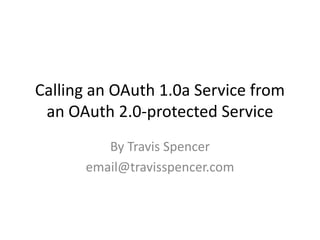Calling an OAuth 1.0a API from an OAuth 2.0 API
- 1. Calling an OAuth 1.0a Service from an OAuth 2.0-protected Service By Travis Spencer email@travisspencer.com
- 2. Basic Rundown ŌĆó You want to call the Twitter API from your own API ŌĆó The Twitter service is an OAuth 1.0a Resource Server (RS) ŌĆó Twitter has an OAuth 1.0a Authorization Server (AS) ŌĆó The Twitter service naturally only trusts it's own AS ŌĆó Your service is an OAuth 2 RS and an OAuth 1.0a Twitter client ŌĆó You have an OAuth 2 AS ŌĆó Your service naturally only trusts your AS ŌĆó The Web app that calls your service is an OAuth 2.0 client and must submit Access Tokens (ATs) emitted by your AS (not Twitter's) when calling your service ŌĆó The Resource Owner (RO) is a Twitter user and will authorize your service to call the Twitter API to modify their data ŌĆó The RO authenticates to your AS using Twitter's OAuth 1.0a AS ŌĆó Your AS asks the RO to authorize a third-party client of your service
- 3. User indicates that they would like to grant some Web site access to the resources that your service provides. TwitterŌĆÖs Twitter User OAuth 1.0a (RO) AS Twitter API Your OAuth (OAuth 1.0a 2.0 AS RS) Third-party Your API Web site (OAuth 2.0 (OAuth 2.0 RS/OAuth Client) 1.0a Client)
- 4. User is redirected to your OAuth 2.0 AS. TwitterŌĆÖs Twitter User OAuth 1.0a (RO) AS Twitter API Your OAuth (OAuth 1.0a 2.0 AS RS) Third-party Your API Web site (OAuth 2.0 (OAuth 2.0 RS/OAuth Client) 1.0a Client)
- 5. Your AS gets a Request Token (RT) from TwitterŌĆÖs AS by making an authenticated call using your Twitter client key. TwitterŌĆÖs Twitter User OAuth 1.0a (RO) AS Twitter API Your OAuth (OAuth 1.0a 2.0 AS RS) Third-party Your API Web site (OAuth 2.0 (OAuth 2.0 RS/OAuth Client) 1.0a Client)
- 6. Your AS redirects the user to Twitter w/ the RT and a digital signature. TwitterŌĆÖs Twitter User OAuth 1.0a (RO) AS Twitter API Your OAuth (OAuth 1.0a 2.0 AS RS) Third-party Your API Web site (OAuth 2.0 (OAuth 2.0 RS/OAuth Client) 1.0a Client)
- 7. The user authenticates to Twitter if they donŌĆÖt have a session already. TwitterŌĆÖs Twitter User OAuth 1.0a (RO) AS Twitter API Your OAuth (OAuth 1.0a 2.0 AS RS) Third-party Your API Web site (OAuth 2.0 (OAuth 2.0 RS/OAuth Client) 1.0a Client)
- 8. The user grants your API access to TwitterŌĆÖs API. TwitterŌĆÖs Twitter User OAuth 1.0a (RO) AS Twitter API Your OAuth (OAuth 1.0a 2.0 AS RS) Third-party Your API Web site (OAuth 2.0 (OAuth 2.0 RS/OAuth Client) 1.0a Client)
- 9. Twitter redirects the user to your ASŌĆÖs callback URL w/ the RT from before. TwitterŌĆÖs Twitter User OAuth 1.0a (RO) AS Twitter API Your OAuth (OAuth 1.0a 2.0 AS RS) Third-party Your API Web site (OAuth 2.0 (OAuth 2.0 RS/OAuth Client) 1.0a Client)
- 10. Your AS exchanges the RT for an Access Token (AT) and stores/associates this with the user. TwitterŌĆÖs Twitter User OAuth 1.0a (RO) AS Twitter API Your OAuth (OAuth 1.0a 2.0 AS RS) Third-party Your API Web site (OAuth 2.0 (OAuth 2.0 RS/OAuth Client) 1.0a Client)
- 11. Your AS redirects the user with an Access Code (AC) to the callback URL of the third-party consumer of your API. TwitterŌĆÖs Twitter User OAuth 1.0a (RO) AS Twitter API Your OAuth (OAuth 1.0a 2.0 AS RS) Third-party Your API Web site (OAuth 2.0 (OAuth 2.0 RS/OAuth Client) 1.0a Client)
- 12. The client exchanges the AC for a new AT specific to your API by authenticating w/ the client key you gave them. TwitterŌĆÖs Twitter User OAuth 1.0a (RO) AS Twitter API Your OAuth (OAuth 1.0a 2.0 AS RS) Third-party Your API Web site (OAuth 2.0 (OAuth 2.0 RS/OAuth Client) 1.0a Client)
- 13. The client calls your API with an AT from your AS. TwitterŌĆÖs Twitter User OAuth 1.0a (RO) AS Twitter API Your OAuth (OAuth 1.0a 2.0 AS RS) Third-party Your API Web site (OAuth 2.0 (OAuth 2.0 RS/OAuth Client) 1.0a Client)
- 14. Your API looks up the Twitter AT by submitting the one presented to your API. TwitterŌĆÖs Twitter User OAuth 1.0a (RO) AS Twitter API Your OAuth (OAuth 1.0a 2.0 AS RS) Third-party Your API Web site (OAuth 2.0 (OAuth 2.0 RS/OAuth Client) 1.0a Client)
- 15. Your API calls the Twitter API using the previously granted access. TwitterŌĆÖs Twitter User OAuth 1.0a (RO) AS Twitter API Your OAuth (OAuth 1.0a 2.0 AS RS) Third-party Your API Web site (OAuth 2.0 (OAuth 2.0 RS/OAuth Client) 1.0a Client)
- 16. The Twitter data is used and your API returns the results. TwitterŌĆÖs Twitter User OAuth 1.0a (RO) AS Twitter API Your OAuth (OAuth 1.0a 2.0 AS RS) Third-party Your API Web site (OAuth 2.0 (OAuth 2.0 RS/OAuth Client) 1.0a Client)
















